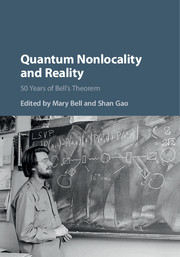Book contents
- Frontmatter
- Contents
- Contributors
- Preface
- Preface
- Part I John Stewart Bell: The Physicist
- Part II Bell's Theorem
- 4 What Did Bell Really Prove?
- 5 The Assumptions of Bell's Proof
- 6 Bell on Bell's Theorem: The Changing Face of Nonlocality
- 7 Experimental Tests of Bell Inequalities
- 8 Bell's Theorem without Inequalities: On the Inception and Scope of the GHZ Theorem
- Part III Nonlocality: Illusion or Reality?
- Part IV Nonlocal Realistic Theories
- Index
- References
8 - Bell's Theorem without Inequalities: On the Inception and Scope of the GHZ Theorem
from Part II - Bell's Theorem
Published online by Cambridge University Press: 05 September 2016
- Frontmatter
- Contents
- Contributors
- Preface
- Preface
- Part I John Stewart Bell: The Physicist
- Part II Bell's Theorem
- 4 What Did Bell Really Prove?
- 5 The Assumptions of Bell's Proof
- 6 Bell on Bell's Theorem: The Changing Face of Nonlocality
- 7 Experimental Tests of Bell Inequalities
- 8 Bell's Theorem without Inequalities: On the Inception and Scope of the GHZ Theorem
- Part III Nonlocality: Illusion or Reality?
- Part IV Nonlocal Realistic Theories
- Index
- References
Summary
Introduction
Since its inception, fifty years ago, Bell's theorem has had a long history not only of experimental tests but also of theoretical developments. Studying pairs of correlated quantummechanical particles separated in space, in a composite “entangled” state, Bell [1] showed that the joint ascription of hidden variables and locality to the system led to an inequality that is violated by the predictions of quantum mechanics. Fifteen years later, experiments confirmed the predictions of quantum mechanics, ruling out a large class of local realist theories.
One of the most meaningful theoretical developments that followed Bell's work was the Greenberger–Horne–Zeilinger (GHZ) theorem, also known as Bell's theorem without inequalities. In 1989, the American physicists Daniel Greenberger and Michael Horne, who had been working on Bell's theorem since the late 1960s, together with the Austrian physicist Anton Zeilinger, introduced a novelty into the testing of entanglement, extending Bell's theorem in a different and interesting direction. According to Franck Laloë [2],
For many years, everyone thought that Bell had basically exhausted the subject by considering all really interesting situations, and that two-spin systems provided the most spectacular quantum violations of local realism. It therefore came as a surprise to many when in 1989 Greenberger, Horne, and Zeilinger (GHZ) showed that systems containing more than two correlated particles may actually exhibit even more dramatic violations of local realism.
The trio analyzed the Einstein, Podolsky, and Rosen 1935 argument once again and were able to write what are now called Greenberger–Horne–Zeilinger (GHZ) entangled states, involving three or four correlated spin-1/2 particles, leading to conflicts between local realist theories and quantum mechanics. However, unlike Bell's theorem, the conflict now was not of a statistical nature, as was the case with Bell's theorem, insofar as measurements on a single GHZ state could lead to conflicting predictions with local realistic models [3–5]. In this paper we present the history of the creation of this theorem and analyze its scope.
- Type
- Chapter
- Information
- Quantum Nonlocality and Reality50 Years of Bell's Theorem, pp. 141 - 148Publisher: Cambridge University PressPrint publication year: 2016



